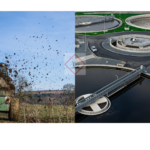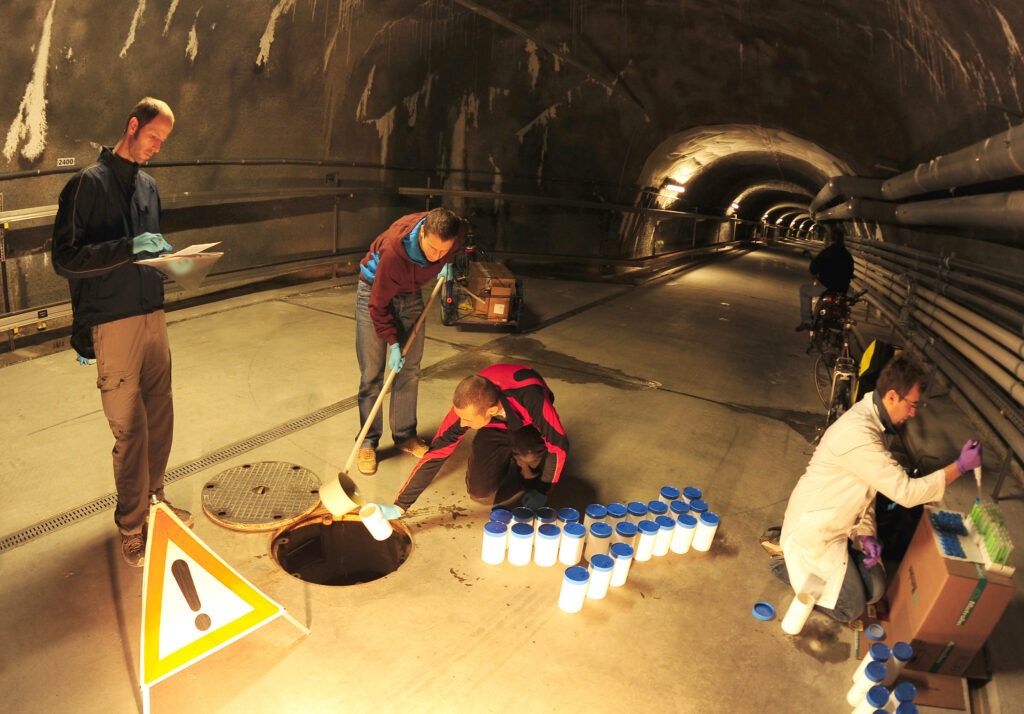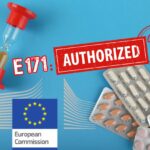
Nanoparticles in Wastewater Treatment Plants

By the AVICENN team – Last updated November 2019
(Residues of) nanoparticles in wastewater treatment plants
Nanomaterials – or their residues – present in numerous consumer products, plant protection products or industrial effluents arrive at wastewater treatment plants. In 2013, researchers estimated that between 0.4 and 7% of the 300,000 tons of manufactured nanomaterials produced worldwide in 2010 were released in water1Global life cycle releases of engineered nanomaterials, Keller AA et al, Journal of Nanoparticle Research, 15:1692, May 2013
See also:
– Discovery and Characterization of Silver Sulfide Nanoparticles in Final Sewage Sludge Products, Kim B. et al, Environmental Science & Technology, 44 (19), 7509-7514, September 2010: nanoscale silver sulfide particles were detected in sewage sludge
– Characterization of Nanomaterials in Metal Colloid-Containing Dietary Supplement Drinks and Assessment of Their Potential Interactions after Ingestion, Reed RB et al, ACS Sustainable Chem. EngJune 2014.
What is the impact on the operation of wastewater treatment plants?
It is feared that nanomaterials – in particular, nano silver2– Review: Issues of Silver Nanoparticles in Engineered Environmental Treatment Systems, Water, Air, & Soil Pollution, April 2014
– Different susceptibilities of bacterial community to silver nanoparticles in wastewater treatment systems, Journal of Environmental Science and Health, Part A: Toxic/Hazardous Substances and Environmental Engineering, 49(6), February 2014 or copper oxide nanoparticles3See for example Inhibition of anaerobic wastewater treatment after long-term exposure to low levels of CuO nanoparticles, Water Research, 2014 – could destroy the bacteria used to degrade organic matter, which would jeopardize the proper functioning of wastewater treatment plants.
In 2009, with scientific references to support their claims4Silver and Compounds Registration Review, Tri-TAC, September 2009, water managers in the United States warned the U.S. Environmental Protection Agency (EPA) of the harmful effects of nanosilver on the operation of wastewater treatment plants and the environment.
Other studies have since confirmed these concerns: studies have established that some engineered nanomaterials can have detrimental effects on wastewater treatment processes, inhibiting the anaerobic or denitrification processes in wastewater treatment plants5According to the OECD (in Nanomaterials in waste streams, November 2015), at high concentrations, engineered nanomaterials with metallic properties could inhibit the anaerobic or denitrification process, impacting bacterial communities and potentially undermining the facility’s ability to reduce sludge toxicity over time :
– Impacts of Silver Nanoparticle Coating on the Nitrification Potential of Nitrosomonas europaea, Arnaout CL et al, About. Sci. Technol., 2012
– Five reasons to use bacteria when assessing manufactured nanomaterial environmental hazards and fates, Holden P. et al, Current Opinion in Biotechnology, 27: 73-78, 2014
– Biosorption if Nanoparticles to Heterotrophic Wastewater Biomass, Kiser et al, Water Research, 44(14): 4105-4114, 2010
– Effects of CeO2 and ZnO nanoparticles on Anaerobic Digestion and Toxicity of Digested Sludge, Nguyen, MD, Master’s thesis – Dalat University, Viet Nam]], 2013
– Nanosilver impact on methanogenesis and biogas production from municipal solid waste, Yang et al, Waste Management, 32: 816-825, 2013
– See also: of total oxygen uptake by silica nanoparticles in activated sludge, Journal of Hazardous Materials, 283(11): 841-846, February 2015. but the few studies on the issue are not all concordant, and the effects are not the same depending on the type of nanomaterials and surface coatings6Cf. Fate of manufactured nanomaterials in sewage treatment plants and agricultural land application, Bottero JY, OECD, November 2015.
What happens to the nanomaterials that arrive in wastewater treatment plants?
Wastewater treatment plants are not well equipped to filter nanomaterials and some end up in our rivers and drinking water.
Estimates vary according to research7According to a study published in March 2015, U.S. wastewater treatment plants are not equipped to properly filter titanium dioxide nanoparticles; see press release: Are Current Water Treatment Methods Sufficient to Remove Potentially Harmful Engineered Nanoparticles?”, Liebert Pub. March 10, 2015
See also:
– An example of low filtration rates highlighted by researchers in the US: Evaluating nanoparticle breakthrough during drinking water treatment, Environmental Health Perspectives, Abbott Chalew TE et al, 121(10):1161-1166, July 2013
– more optimistic estimates by Swiss researchers: Transformation of AgCl nanoparticles in a sewer system A field study, Kaegi R et al., Science of The Total Environment, 535: 20-27, December 2015 (95% of nanoparticles would be filtered out) and Waters contain only a small proportion of silver nanoparticles from consumer products, Eawag, April 2013 → Fate and transformation of silver nanoparticles in urban wastewater systems, Kaegi R et al., Water Research, 47(12), 3866-3877, August 2013 but a large majority of the nanomaterials (by mass) appear to be captured and concentrated in the sludge of wastewater treatment plants.
Estimates of nanomaterial concentrations in sludge vary among studies:
- Some measurements have shown that the sludge contains 10 to 30 mg of silver per kg of dry sludge (including silver nanoparticles and silver ions)8These figures were quoted by Franck Vanderbulcke, professor at the University of Lille during the May 6 session on nano silver at ForumNanoResp, May 2015.
- Other estimates have established the following concentrations of nanomaterials in WWTP sludge: 10 mg/kg cerium oxides (CeO2), 2 mg/kg silver (Ag), 370 mg/kg to 2000 mg/kg titanium dioxide (TiO2), 65 mg/kg zinc oxides (ZnO)9Estimating Potential Life Cycle Releases of Engineered Nanomaterials from Wastewater Treatment Plants, Lazareva A, Keller AA, ACS Sustainable Chemistry & Engineering, 2: 1656-1665, 2014.
- According to another study, in soils on which sewage sludge has been spread, it is the CeO2 and TiO2 nanoparticles that would be at the top of the list and water treatments lead to extremely low concentrations of ZnO nanoparticles and silver (Ag) nanoparticles in the environment10Modeling Flows and Concentrations of Nine Engineered Nanomaterials in the Danish Environment, Gottschalk F et al., Int. J. About. Res. Public Health, 12(5), 5581-5602, 2015.
A group of researchers from Eawag and ETH Zurich have shown that almost all plastic nanoparticles are retained in sewage sludge11STEPs effective with nanoplastics, The Morning, February 5, 2019; Synthesis of metal-doped nanoplastics and their utility to investigate fate and behaviour in complex environmental systems, Mitrano DM et al, Nature Nanotechnology, February 4, 2019.

Regardless of the performance of the plants, if nothing is done to restrict the emission of nanomaterials, the quantities of unfiltered nanoparticles released into surface waters will grow along with these products, which are invading the market at a rate far greater than the rate at which wastewater treatment plants around the world are modernized.
What are (and will be) the consequences on aquatic fauna and flora? The studies are developing and the alarming results are accumulating12Effect of Ozone Treatment on Nano-Sized Silver Sulfide in Wastewater Effluent, Thalmann B et al, About. Sci. Technol., 49(18) : 10911-10919, 2015.
What is the impact on agricultural soils where sludge from wastewater treatment plants is spread?
Between 70 and 80% of the sludge from wastewater treatment plants is spread on agricultural land to complete the treatment process while serving as fertilizer (the rest is incinerated or landfilled)13See in particular:
– Bilan de dix années d’application de la réglementation relative à l’épandage des boues issus du traitement des eaux usées, Ministère de l’alimentation, de l’agriculture et de la pêche /CGAAER : Jean-Paul Legroux/ CGEDD : Claude Truchot /Rapport n° 1771
– L’épandage des boues de stations de épuration urbaines et industrielles sur les sols agricoles, Ministère de l’écologie.. While some metal contaminants are monitored, there is no obligation to monitor the nanometric forms of these contaminants and silver, even in non-nanoscale form, is currently neither systematically tracked nor regulated.

In 2012, Swedish researchers found that the nanosilver in textiles that was found in the sewage sludge produced toxic effects on the earthworms that were exposed to it14Assessing the Environmental Risks of Silver from Clothes in an Urban Area, Arvidsson R et al, Human and Ecological Risk Assessment, 20(4), June 2012.
In Germany, research in 2013 confirmed that silver nanoparticles can be toxic to soil microorganisms essential to the natural nitrogen cycle. Adverse effects may occur from 30 mg silver nanoparticles per kilogram of sludge applied (based on typical application rates in Germany of five tons per hectare of agricultural land every three years)15Hazard assessment of a silver nanoparticle in soil applied via sewage sludge, Environmental Sciences Europe, 25(17), 2013 (see abstract Silver nanoparticles in sewage sludge harmful to soil microorganisms, “Science for Environment Policy”, 351, November 2013).
Since 2014, French researchers at ISTERRE have been studying the fate of silver nanoparticles in cultivated soils after spreading contaminated sewage plant sludge: they have found changes in soil enzyme activity, even at low doses.
At the end of 2015, the OECD published a report that considered the agricultural spreading of wastewater treatment sludge “alarming” in view of the risks associated with the presence of nanomaterials in this sludge16Cf. Nanomaterials in Waste Streams, OECD, November 2015.
How can we avoid repeating the mistakes of the past?
How can we learn from the past? In France, in the 1970s and 1980s, experiments focused on the transfer of heavy metals from sewage sludge to soils and crops and into the food chain17Danielle Lanquetuit, 1979-1986, with the Seine Normandy Water Agency. The urban-rural debate was divided between the benefits of a complementary and biological recycling by the soils, with a dilution of undesirable elements, and farmers’ refusal to accept a transfer of pollution from urban to rural areas, with no safeguards in case of negative impacts18For more information on the transactions between different stakeholders in France and Europe over the period 1986-2000, see L’épandage agricole des boues de stations d’épuration d’eaux usées urbaines, Alexandre Dudkowski, INRA-ME&S, Le Courrier de l’environnement de l’Inra, August 2000.
The first traceability monitoring focused on heavy metals or metallic trace elements (TMEs: chromium, nickel, cadmium, copper, zinc, lead, mercury, even selenium…) in the 1980s was then extended to 10 organic micro-pollutants in the 1990s, and studies were carried out on the impact of estrogens (from human urine and contraceptives) concentrated in wastewater and their endocrine disruptor effect on aquatic fauna19Cf. Devenir des oestrogènes dans les stations d’épuration, INRA, 2009 and Ecodynamique et écotoxicologie des oestrogènes au cours du traitement des eaux résiduaires et des boues urbaines, thesis of M. Muller published in 2008.
In 2013, ADEME still used the terms “recycling” by agricultural spreading of waste, regulated by Decree No. 97-1133 of December 8, 1997 and the Order of January 8, 1998, as well as prefectural orders20An example in the Haut Rhin: http: //www.smra68.net/les-regles-epandage/reglementation-boues.html.. A guarantee fund has been set up to compensate farmers and farm owners for any damage suffered as a result of urban or industrial sewage sludge being spread on their land21See article L425-1 of the insurance code and decree no. 2009-550 of 18/05/2009.
⇒ The same round of debates between stakeholders resumes with each new wave of awareness of emerging pollutants, leading to an increase in treatment performance obligations in wastewater treatment plants and vigilance throughout the recycling chain. The nanosilver wave is under study: how many years will it take before we get a response in line with what is at stake? Should we let the development of mass uses take place or should we learn from past similar experiences? It is still necessary to be able to identify the main sources of nanomaterial release into wastewater – a task that is still in its infancy, through the R-Nano register in France.
The potential transformation of engineered nanomaterials in soil, their interactions with plants and bacteria in the rhizosphere and their transfer to surface water are just beginning to be studied.
In French :
- Presence and fate of nanomaterials in collective sanitation: state of the art (Record Project), ), V. Vancauwenberghe, M-A. Marcoux, M. Matias-Mendes, J-P. Jaeg, April 2020
- Sewage sludge under the microscope, The Earth from home (Canada), October 2019
- Behavior of nanoparticles in the potabilization process, Aqua & Gas, November 2018
- Nanomaterials in Waste Streams and Fate of Manufactured Nanomaterials in Wastewater Treatment Plants and Agricultural Land Application, OECD, November 2015
- Fate of silver nanoparticles in cultivated soils after land application of contaminated sewage plant sludge, interview with Géraldine Sarret, EnvitéRA, 2015
- Nanoparticles, both remedy and pollution for wastewater treatment plants, Actu Environnement, 24 August 2015
- The uses of nano silver and Proceedings of the May 6 session on nano silver, ForumNanoResp, May 2015 (paragraph on toxic risks and bacterial resistance)
- Sequestration, quantification and fate of silver nanoparticles in wastewater, Gagnon J, UQAR (Université du Québec à Rimouski), intervention at the 83rd Acfas Congress, Colloque 210 – Présence, persistance, devenir et effets des nanomatériaux dans l’environnement, May 2015
- Valorization of fertilizing materials of waste origin on soils for agricultural or forestry use – Agronomic, environmental, socio-economical impacts, Summary of the collective scientific expertise, CNRS, INRA, IRSTEA, July 2014
- NANOSEP (Aggregation and Separation Processes for Nanoparticles), ANR project, 2009-2012
– In English:
- The impact of silver nanoparticles on microbial communities and antibiotic resistance determinants in the environment, Yonathan K et al, Environmental Pollution, 293, January 2022
- Occurrence, characterisation and fate of (nano)particulate Ti and Ag in two Norwegian wastewater treatment plants, Polesel F et al, Water Research, 141:19-31, April 2018
- Accumulating over time, even low concentrations of silver can foil wastewater treatment
Oregon State University, May 14, 2018 - Fates and Impacts of Nanomaterial Contaminants in Biological Wastewater Treatment System: a Review
, Wu J et al, Water, Air, & Soil Pollution, 229:9, January 2018 - Fate of Ag-NPs in sewage sludge after application on agricultural soils, Pradas del Real A et al, ES&T, 2016
- Toxicity of TiO2 nanoparticle to denitrifying strain CFY1 and the impact on microbial community structures in activated sludge, Li D et al, Chemosphere, 2015
- Potential exposure and treatment efficiency of nanoparticles in water supplies based on wastewater reclamation, Kirkegaard P et al, Environ. Sci.: Nano, 2, 191-202, 2015
- Monte Carlo simulations of the transformation and removal of Ag, TiO2, and ZnO nanoparticles in wastewater treatment and land application of biosolids, Science of The Total Environment, 511: 535-543, April 2015
- Are Current Water Treatment Methods Sufficient to Remove Potentially Harmful Engineered Nanoparticles?“, Liebert Pub, March 10, 2015
- Potential exposure and treatment efficiency of nanoparticles in water supplies based on wastewater reclamation, Kirkegaard P et al, ES&T, 2015
- Transformation of AgCl nanoparticles in a sewer system – A field study, Science of The Total Environment, Kaegi R et al, 2015
- Simultaneous removal of nanosilver and fullerene in sequencing batch reactors for biological wastewater treatment, Yang Y et al, Chemosphere, 2015
- Sources, Distribution, Environmental Fate, and Ecological Effects of Nanomaterials in Wastewater Streams, Kunhikrishnan A et al, Critical Reviews in Environmental Science and Technology, 45(4), January 2015
- Controlled Evaluation of Silver Nanoparticle Sulfidation in a Full-Scale Wastewater Treatment Plant, Environmental Science & Technology, 2014
- Transport and fate of silver as polymer-stabilised nanoparticles and ions in a pilot wastewater treatment plant, followed by sludge digestion and disposal of sludge/soil mixtures: A case study, Journal of Environmental Science and Health, Part A: Toxic/Hazardous Substances and Environmental Engineering, 49(12): 1416-1424, 2014
- Nano-silver in drinking water and drinking water sources: stability and influences on disinfection by-product formation, Environmental Science and Pollution Research, 21(20): 11823-11831, October 2014
- How does the entering of copper nanoparticles into biological wastewater treatment system affect sludge treatment for VFA production, Water Research, 63: 125-134, October 2014
- Removal of TiO2 nanoparticles during primary water treatment: Role of coagulant type, dose, and nanoparticle concentration, Honda R, University of California Riverside, PhD dissertation, August 2014
- Monitoring silver nanoparticles in a wastewater treatment plant, Ron Kent, Virginia Tech sustainable nanotechnology, July 15, 2014
- Fate of Zinc Oxide and Silver Nanoparticles in a Pilot Wastewater Treatment Plant and in Processed Biosolids, Ma R et al, About. Sci. Technol., 48 (1): 104-112, January 2014
- A review of the detection, fate and effects of engineered nanomaterials in wastewater treatment plants, Water Sci Technol, 68(7):1440-53, 2013
- The toxicity of silver nanoparticles to zebrafish embryos increases through sewage treatment processes, Ecotoxicology, 22(8), 1264-1277, October 2013
- Fate and transformation of silver nanoparticles in urban wastewater systems, Kaegi R et al, Water Research, 47(12), August 2013
- Engineered nanoparticles in wastewater and wastewater sludge – Evidence and impacts, Waste Management, 30(3): 504-520, March 2010
Any questions or comments? This information sheet compiled by AVICENN is intended to be completed and updated. Please feel free to contribute.
Upcoming Nano Agenda

- Scientific conference
- 23rd International conference on Advanced Nanomaterials
- From July 23 to July 25, 2025
- Website: www.advanced-nanomaterials-conference.com

- E-learning program: awareness-raising for personnel who come into contact with nanomaterials during research, formulation, production, maintenance, cleaning, upkeep, etc., as well as safety coordinators or engineers, facility managers, heads of laboratories where nanoparticles are handled.
- Organizers: INSTN Grenoble (CEA)
- On the program:
- 1 – Introduction, definition and characteristics of nanomaterials
- 2 – Toxicity of nanomaterials: the state of knowledge
- 3 – Metrology and characterization of nanomaterials
- 4 – Prevention and protection against nanomaterials in the workplace
- 5 – Quiz: assessment of learning outcomes
- The 2-hour course can be viewed for one month from the date of registration.
- Website: https://instn.cea.fr/…risques-lies-aux-nanomateriaux…

- 10th International Conference on Nanoscience and Technology
- Organized by: Chinese Academy of Sciences and Chinese National Center for Nanoscience and Technology
- Website: http://www.chinanano.org.cn/en/
Created in September 2012
Notes and references
- 1Global life cycle releases of engineered nanomaterials, Keller AA et al, Journal of Nanoparticle Research, 15:1692, May 2013
See also:
– Discovery and Characterization of Silver Sulfide Nanoparticles in Final Sewage Sludge Products, Kim B. et al, Environmental Science & Technology, 44 (19), 7509-7514, September 2010: nanoscale silver sulfide particles were detected in sewage sludge
– Characterization of Nanomaterials in Metal Colloid-Containing Dietary Supplement Drinks and Assessment of Their Potential Interactions after Ingestion, Reed RB et al, ACS Sustainable Chem. EngJune 2014 - 2– Review: Issues of Silver Nanoparticles in Engineered Environmental Treatment Systems, Water, Air, & Soil Pollution, April 2014
– Different susceptibilities of bacterial community to silver nanoparticles in wastewater treatment systems, Journal of Environmental Science and Health, Part A: Toxic/Hazardous Substances and Environmental Engineering, 49(6), February 2014 - 3See for example Inhibition of anaerobic wastewater treatment after long-term exposure to low levels of CuO nanoparticles, Water Research, 2014
- 4Silver and Compounds Registration Review, Tri-TAC, September 2009
- 5According to the OECD (in Nanomaterials in waste streams, November 2015), at high concentrations, engineered nanomaterials with metallic properties could inhibit the anaerobic or denitrification process, impacting bacterial communities and potentially undermining the facility’s ability to reduce sludge toxicity over time :
– Impacts of Silver Nanoparticle Coating on the Nitrification Potential of Nitrosomonas europaea, Arnaout CL et al, About. Sci. Technol., 2012
– Five reasons to use bacteria when assessing manufactured nanomaterial environmental hazards and fates, Holden P. et al, Current Opinion in Biotechnology, 27: 73-78, 2014
– Biosorption if Nanoparticles to Heterotrophic Wastewater Biomass, Kiser et al, Water Research, 44(14): 4105-4114, 2010
– Effects of CeO2 and ZnO nanoparticles on Anaerobic Digestion and Toxicity of Digested Sludge, Nguyen, MD, Master’s thesis – Dalat University, Viet Nam]], 2013
– Nanosilver impact on methanogenesis and biogas production from municipal solid waste, Yang et al, Waste Management, 32: 816-825, 2013
– See also: of total oxygen uptake by silica nanoparticles in activated sludge, Journal of Hazardous Materials, 283(11): 841-846, February 2015. - 6Cf. Fate of manufactured nanomaterials in sewage treatment plants and agricultural land application, Bottero JY, OECD, November 2015
- 7According to a study published in March 2015, U.S. wastewater treatment plants are not equipped to properly filter titanium dioxide nanoparticles; see press release: Are Current Water Treatment Methods Sufficient to Remove Potentially Harmful Engineered Nanoparticles?”, Liebert Pub. March 10, 2015
See also:
– An example of low filtration rates highlighted by researchers in the US: Evaluating nanoparticle breakthrough during drinking water treatment, Environmental Health Perspectives, Abbott Chalew TE et al, 121(10):1161-1166, July 2013
– more optimistic estimates by Swiss researchers: Transformation of AgCl nanoparticles in a sewer system A field study, Kaegi R et al., Science of The Total Environment, 535: 20-27, December 2015 (95% of nanoparticles would be filtered out) and Waters contain only a small proportion of silver nanoparticles from consumer products, Eawag, April 2013 → Fate and transformation of silver nanoparticles in urban wastewater systems, Kaegi R et al., Water Research, 47(12), 3866-3877, August 2013 - 8These figures were quoted by Franck Vanderbulcke, professor at the University of Lille during the May 6 session on nano silver at ForumNanoResp, May 2015
- 9Estimating Potential Life Cycle Releases of Engineered Nanomaterials from Wastewater Treatment Plants, Lazareva A, Keller AA, ACS Sustainable Chemistry & Engineering, 2: 1656-1665, 2014
- 10Modeling Flows and Concentrations of Nine Engineered Nanomaterials in the Danish Environment, Gottschalk F et al., Int. J. About. Res. Public Health, 12(5), 5581-5602, 2015
- 11STEPs effective with nanoplastics, The Morning, February 5, 2019; Synthesis of metal-doped nanoplastics and their utility to investigate fate and behaviour in complex environmental systems, Mitrano DM et al, Nature Nanotechnology, February 4, 2019
- 12Effect of Ozone Treatment on Nano-Sized Silver Sulfide in Wastewater Effluent, Thalmann B et al, About. Sci. Technol., 49(18) : 10911-10919, 2015
- 13See in particular:
– Bilan de dix années d’application de la réglementation relative à l’épandage des boues issus du traitement des eaux usées, Ministère de l’alimentation, de l’agriculture et de la pêche /CGAAER : Jean-Paul Legroux/ CGEDD : Claude Truchot /Rapport n° 1771
– L’épandage des boues de stations de épuration urbaines et industrielles sur les sols agricoles, Ministère de l’écologie. - 14Assessing the Environmental Risks of Silver from Clothes in an Urban Area, Arvidsson R et al, Human and Ecological Risk Assessment, 20(4), June 2012
- 15Hazard assessment of a silver nanoparticle in soil applied via sewage sludge, Environmental Sciences Europe, 25(17), 2013 (see abstract Silver nanoparticles in sewage sludge harmful to soil microorganisms, “Science for Environment Policy”, 351, November 2013)
- 16Cf. Nanomaterials in Waste Streams, OECD, November 2015
- 17Danielle Lanquetuit, 1979-1986, with the Seine Normandy Water Agency
- 18For more information on the transactions between different stakeholders in France and Europe over the period 1986-2000, see L’épandage agricole des boues de stations d’épuration d’eaux usées urbaines, Alexandre Dudkowski, INRA-ME&S, Le Courrier de l’environnement de l’Inra, August 2000
- 19Cf. Devenir des oestrogènes dans les stations d’épuration, INRA, 2009 and Ecodynamique et écotoxicologie des oestrogènes au cours du traitement des eaux résiduaires et des boues urbaines, thesis of M. Muller published in 2008
- 20An example in the Haut Rhin: http: //www.smra68.net/les-regles-epandage/reglementation-boues.html.
- 21See article L425-1 of the insurance code and decree no. 2009-550 of 18/05/2009






